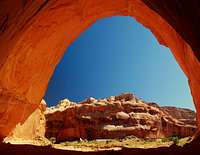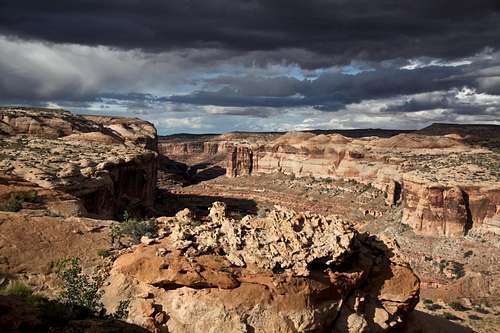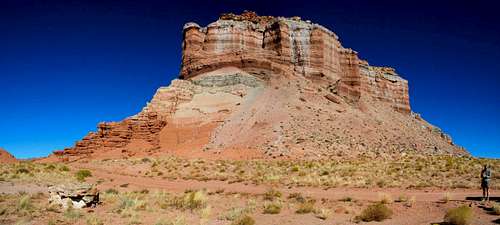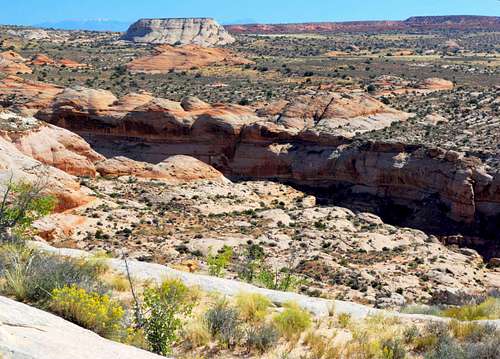-
 17654 Hits
17654 Hits
-
 90.81% Score
90.81% Score
-
 33 Votes
33 Votes
|
|
Canyon |
|---|---|
|
|
38.46560°N / 110.1982°W |
|
|
Hiking |
|
|
Spring, Summer, Fall, Winter |
|
|
Overview
Out here, step into not only our ancient origins but also into a world that was so ancient as to be most likely unknown to the enigmatic people who left in this place their puzzles for the glory of their gods, the health of their people, personal vanity, or maybe, just maybe, for us. To behold what wonders this canyon holds is to at once feel small and insignificant yet also part of a fluid, beautiful, and complex thread that binds us all through not only the generations and the centuries but also the millennia and the ages.
Horseshoe Canyon, a detached and remote unit of Utah’s Canyonlands National Park (and part of the Maze District), holds what may be the finest concentrated display of Native American rock art—pictographs (paintings) here—in all of the United States. The heart of it all is the Great Gallery, dominated by the cryptic “Holy Ghost” about whom interpretations abound but certainties are absent.
But it is not just the images, amazing in both their longevity and their detail, that make this canyon an outdoor museum unrivaled by anything built of concrete, marble, and steel. Out here also are well-preserved dinosaur tracks that make the long-vanished human inhabitants and the artist(s) among them seem like ghosts of yesterday rather than of the almost unimaginably distant times during which they actually lived.
And the natural scenery, well, it is just replete with your typical sheer, soaring red walls that so define the amazing geologic masterpiece that is southern Utah.
A Confession and a Conversion
An English major and teacher, I can be moved to tears by the artistry of words, but painting does little for me, and so it was not by basic nature that I came to see this area and others like it in such reverential terms. In fact, before I beheld such places, one could have heard me dismiss them as graffiti. After all, what would people call it if I walked up to a rock wall, scratched an image of a bird on it, and walked away? “Vandal” would just be a euphemism in that case, wouldn’t it? And so I felt for a long time, most likely because I associated appreciation of rock art with crowds of people who went to the wilderness to see the handiwork of man, something bewildering and antithetical to the very idea of wilderness to me. An unfair assessment, yes, but nevertheless what I felt.
And then something just piqued my interest and out there I went. And it was more than beautiful, more than amazing. I lack the adjectives for it, in fact. As I stood in the exact spot where some visionary stood thousands of years before, I felt surrounded by the spirits and the power of the past. There is something about such places that makes one step softly and speak in hushed tones, and so I did. I cannot explain exactly why. Reverence? Respect? Fear? Awe? All I know is that I couldn’t stop gaping at not just the magic in front of me but also at my stupidity for dismissing it so arrogantly, so cavalierly, for so long. Now, I still have no love or interest for the canvas works that hang in museums or private galleries, but I rave about the wonders among the walls of the Southwest, and I encourage, implore, those who haven’t seen them to go and those who have to spread the word to others, others they feel can appreciate them. Like the mountains, these ancient gestures of no one really understands what can give us all some much-needed perspective, humility, and empathy.
Getting There
A dirt road heads south from Green River; head for the airport and pick up County Road. From there, just stick with the main artery until the signed spur to the canyon. Distance from the start of County Road is about 43 miles. The road is a little rough and sandy in places but is passable to most vehicles when dry.
The Canyon
This is a hike, not a climb, and the RT length and elevation gained hiking back out make this a moderately difficult venture for the average person. Strong hikers will find it easy, but casual hikers will likely find it grueling, especially in hot weather. It is a good idea to avoid this hike from June through August, but the canyon is accessible year-round, excepting temporarily impassible road conditions due to snow or heavy rain.
From the trailhead, where Horseshoe Canyon does not appear especially spectacular, hike down the well-maintained trail to the floor of the canyon. About ten minutes from the trailhead, on the left side of the trail, are two dinosaur prints (from different animals) embedded in the rock. These tracks are anywhere from 50 to 100 million years old. Talk about the Fountain of Youth, or at least the Rock of Feeling Younger! The larger and more obvious one is of a three-toed creature, and it is wide enough for you to put your entire hand inside the “palm” of the print. A photograph of this print on the sign at the trailhead may help you spot it. I do not have a picture of it because I felt that capturing a good image would have required filling the print with enough sand to show the outline, depth, and breadth; and I felt that would have been cheating.
It is about 1.3 miles from the trailhead to the canyon floor, and you descend over 500 feet to get there. From the floor, look for a trail winding upcanyon. You can follow the canyon floor all the way to the Great Gallery, but you may miss some of the other art sites if you do so. Both the cairned trail and the bed of Barrier Creek offer easy hiking in most conditions. Either way, head right. You can probably find wonderful seclusion if you go left, but you won’t see any rock art.
The first site is about 0.5 miles upcanyon, high and left. Almost directly across from it is the second, Horseshoe Shelter. Next, about another half-mile upcanyon, is the Alcove, where there is nice Archaic art but, sadly, true vandalism, too. Don’t let that diminish your enjoyment of the hike; a worthwhile prize does await.
Almost four miles from the trailhead, hikers will finally come upon the Great Gallery, the highlight of the canyon. Park Service Rangers may be present, and if they are, hiking up and into the alcove sheltering this unbelievable place will mean going up there with them. Understand that they are there to educate visitors and enhance their experiences but that they are also there to protect this special and incredibly vulnerable place. Whether the rangers are there or not, DO NOT TOUCH THE PAINTINGS! Viewing the figures up close gives one a sense of being in the presence of the people who lived here and sharing a moment of their lives, but the figures actually look better from a distance, as they seem to take on a three-dimensional aspect.
Just beyond the Great Gallery are some dinosaur tracks preserved in a streambed, but as of 2006, they were buried under sand and impossible to locate. A storm could come through and change everything again, but you probably won’t know unless you go and look for yourself.
The Great Gallery
The Great Gallery, like the other sites in Horseshoe Canyon, contains Archaic paintings created between 2000 and 8000 years ago. The nearer end of that span is at least within recorded history; the other end belongs to a time about which we know very little. There are dozens of human and animal and possibly spiritual figures here, and the artists used an astonishing variety of colors derived from ground minerals mixed with some type of liquid base—the predominant theory is that the base was from animal tallow or the juices from vegetables (water would not have worked in such an arid environment). Now, the base is gone, but the minerals’ colors remain.
The Great Gallery is often called the Louvre of the Southwest. Its most famous figure is the whitish Holy Ghost, a seven-foot-tall figure that experts think may symbolize a deity or an especially important ancestor. This site is a national and world treasure; please treat it with according respect.
There are many more photos of scenes from the Great Gallery and the other sites in this page's image gallery. Please peruse them to see more of this amazing ancient art.
Red Tape
Nothing regulatory except the obvious and standard out here-- no touching the rock art, and no fires. Backcountry camping is not allowed in Horseshoe Canyon.Fill up your tank in Green River or in Hanksville, which is 20 miles south of the turnoff from Utah 24.
Remember the desert water rule—carry at least one gallon per person per day. There may be water in the canyon, but don’t count on it or its quality.
You may find solitude out here since it is such a remote area, but don’t count on it. The amazing sights make the crowds tolerable, and most people who come all the way out here and hike down when there are many roadside art sites in Utah have a deep interest in and/or love for these places. So even if there are a lot of people out there when you go, you almost certainly won’t find the circus-like atmosphere that spoils so many popular trails and areas in national parks (think Yosemite Valley, Yellowstone’s Upper Geyser Basin, and the South Rim of the Grand Canyon).













